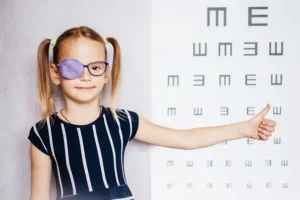So what is Amblyopia? In simple terms, it occurs when without any eye-related condition, the visual acuity drops in children. It happens during the developmental age which is somewhere between 6 months of age to 5-6 years. During the development process, the brain neglects the image formation from one eye (blurred image) and this rejection phenomenon keeps on repeating leading to Amblyopia (suppressed vision) in that eye.
What are the Causes:
Amblyopia is caused by a developmental problem in the brain. The eyes are absolutely alright it’s the brain that couldn’t process the signals coming from one eye. This could be happening if the eye is squinted or has high power. Now even when the underlying cause is treated the amblyopia cannot get resolved as the visual potential of the eye is already compromised. An eye condition that causes amblyopia is ptosis, squint, high myopia (developmental), anisometropia (extreme power difference in both eyes), nystagmus, etc.
Signs and Symptoms:
• Squinting
• Poor stereoscopic vision (3D vision)
• Poor visual acuity
• Poor contrast sensitivity
• Poor pattern recognition
• Complaints of crowded central vision.
• Difficulty in contour detection
• At times amblyopia remains unrecognized till adulthood due to a lack of eye checkups in childhood.
• During the school vision screen when one closed one eye the child complains of blurred vision.
Types of Amblyopia:
1. Refractive amblyopia: This type of amblyopia is associated with an uncorrected
refractive error. It is further divided into two categories.
Anisometropic amblyopia: Anisometropia is a term used when the power difference in both eyes is more than 1 Diopter. When this happens the brain rejects the image formation from the eye having more power leading to amblyopia. In hyperopia, if the power difference is 1 to 1.5 D the chances of amblyopia increase, in myopia difference of 3 to 4 D causes amblyopia, and in astigmatism the difference of 2D or more causes amblyopia.
Isometropic amblyopia: Isometropia is a term used when the power in both the eyes is same. This type of amblyopia is usually Bilateral (In both eyes) and this occurs when a child has more than 5 D of myopia, more than 4 D of hyperopia, or more than 2-3 D of astigmatism.
Meridonial amblyopia: This type is caused by significant astigmatism.
The severity of amblyopia is directly related to the amount of difference in refractive error between two eyes.
2. Strabismic amblyopia:
Strabismus is commonly known as squint. As we know that both eyes are not parallel as a result both eyes receive unequal images and the visual system suppresses the image from the squinted eye leading to amblyopia.
In strabismus, as we know the stimuli received by each eye are different and this leads to disruption in fusion (the ability of the brain to fuse two images into one single image), also binocular vision, and stereopsis (3-D viewing) are compromised.
Thus, if amblyopia is caused by strabismus then it has a major impact on binocular vision.
3. Deprivational amblyopia:
As the name says the light stimulus is blocked from reaching the retina, thus hampering the normal visual process. This happens due to underlying eye disease and if the underlying condition is not treated at a developmental stage then it leads to amblyopia. Eye conditions that cause deprivational amblyopia are as follows:
• Congenital cataract
• Blepharoptosis
• Nystagmus
• Optic nerve coloboma/hypoplasia
• Retinal disorder
• Persistent fetal vasculature, etc.
4. Mixed/combination amblyopia:
When two amblyogenic factors are present it is considered mixed amblyopia. For example, a child has high refractive (refractive amblyopia) errors along with squint (strabismic amblyopia) also it is the most commonly found amblyopia. A combination of refractive error and squint is mostly present in those with partially accommodative esotropia, microtropia, and monofixation syndrome.
Mixed amblyopia is more severe as the person will have defective visual functions, loss of vision, decreased contrast sensitivity, and less and/or absence of stereopsis. The severity of amblyopia depends upon the magnitude of impact on each visual function.
Treatment:
Depending upon the type and severity various treatment options are provided, such as:-
• Correct refractive error either with spectacles or contact lenses.
• Occlusion therapy
• Filters
• Software based therapy
• Treatment of underlying causes by surgery
• Using synaptophore to improve convergence, and divergence and stimulate the retina.
Can we treat amblyopia after attaining certain age?
Ideally, the first 6 months of life is the most important period to treat amblyopia, after this, the chance decreases rapidly. In the first 6 months, the severity of deprivation makes a difference. For example, dense cataracts in both eyes if not treated till 3 months of age will lead to nystagmus and this will impair visual acuity permanently.
In strabismic amblyopia glasses along with an eye patching of the dominant eye is prescribed or pharmacologically the better eye’s vision is blurred (also known as penalization). In penalization usually, the atropine eye drops are installed in the better eye thus the better eye’s vision gets blurred and the other is made to see clearly. This method helps in preventing all the bullying that child has to face while wearing a patch. Also, the other factors leading to amblyopia will be treated surgically or non-surgically depending upon the type and severity of the squint.
Also as we know that a young brain is more adaptable than an adult brain. Meaning a younger person can learn and adapt easily when compared with an adult so there is adaptability at a synaptic level, cellular level, and cortical level for representation.
As we know that amblyopia is a visual development disorder, and its early diagnosis is important for a good visual prognosis. As treatment needs to be done when the visual neurological pathways are controllable to stimulation, recovery, and cortical damage reversal.
Conclusion:
There is a significant difference in the clinical and functional pattern of vision loss amongst the clinically defined categories of amblyopia. Also, it appears to be substantial neural adaptability in the amblyopic brain which can help treat amblyopia in teenage and into adulthood.






